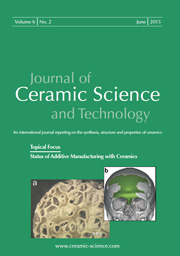Articles
All articles | Recent articles
Room-Temperature Mechanochemical Synthesis and Consolidation of Nanocrystalline HfB2-HfO2 Composite Powders
N. Akçamlı1,2, D. Ağaoğulları1, Ö. Balcı3, M. L. Öveçoğlu1, İ. Duman1
1 Istanbul Technical University, Faculty of Chemical and Metallurgical Engineering, Department of Metallurgical and Materials Engineering, Particulate Materials Laboratories (PML), 34469 Maslak, Istanbul, Turkey
2 Bursa Technical University, Faculty of Natural Sciences, Architecture and Engineering, Department of Metallurgical and Materials Engineering, Yıldırım 16330, Bursa, Turkey
3 Koç University, Department of Chemistry, Rumelifeneri Yolu, 34450 Sarıyer, Istanbul, Turkey
received November 4, 2017, received in revised form January 7, 2018, accepted February 12, 2018
Vol. 9, No. 2, Pages 101-118 DOI: 10.4416/JCST2017-00084
Abstract
This study reports on the in-situ preparation of HfB2-HfO2 composite powders at room temperature by means of mechanochemical synthesis (MCS) from HfCl4-B2O3-Mg powder blends. The effects of milling duration and excess amounts of B2O3 and Mg reactants (20 and 30 wt%) on the HfB2 formation mechanism were investigated. After MCS and purification, HfB2, HfO2 and Mg2Hf5O12 phases were obtained. The Mg2Hf5O12 phase decomposed during the annealing treatment conducted at 1000 °C under Ar flow. The as-synthesized, purified, annealed and subsequently leached powders were characterized with an X-ray diffractometer (XRD), stereomicroscope (SM), scanning electron microscope (SEM), transmission electron microscope (TEM) and particle size analyzer (PSA). The HfB2-HfO2 composite powders with an average particle size of 140 nm and predominantly rounded morphology were consolidated with cold pressing/pressureless sintering (PS) and spark plasma sintering (SPS) techniques. The relative density values of the HfB2-HfO2 composites obtained by means of PS (with 2 wt% Co) and SPS techniques were 91.82 % and 93.79 %, respectively. A relatively high densification rate for the HfB2-HfO2 ceramic was achieved by means of Co addition, which was considered a promising sintering aid for HfB2-based ceramics. The HfB2-HfO2 composite sample consolidated with SPS exhibited hardness, wear volume loss amount and friction coefficient values of 18.45 GPa, 4.30 mm3 and 0.60, respectively.
![]() Download Full Article (PDF)
Download Full Article (PDF)
Keywords
HfB2-HfO2 composites, powders, solid state reaction, sintering, microstructure-final, mechanical properties
References
1 Rapp, B.: Materials for extreme environments: Defense, aviation, and space agencies are beginning to look at the advanced composite materials necessary for hypersonic speeds, Mater. Today, 9, [6], (2006).
2 Orru, R., Cao, G.: Comparison of reactive and non-reactive spark plasma sintering routes for the fabrication of monolithic and composite ultra high temperature ceramics (UHTC) materials, Materials, 6, 1566 – 1583, (2013).
3 Cincotti, A., Licheri, R., Locci, A.M., Orru, R., Cao, G.: A review on combustion synthesis of novel materials: recent experimental and modeling results, J. Chem. Technol. Biot., 78, 122 – 127, (2003).
4 Zhang, X., Li, W., Hong, C., Han, W.: Microstructure and mechanical properties of ZrB2 based composites reinforced and toughened by zirconia, Int. J. Appl. Ceram. Tec., 5, 499 – 504, (2008).
5 Basu, B., Vleugels, J., Biest, O.: Development of ZrO2-ZrB2 composites, J. Alloy. Compd., 334, 200 – 204, (2001).
6 Balcı, Ö., Ağaoğulları, D., Duman, İ., Öveçoğlu, M.L.: Carbothermal production of ZrB2-ZrO2 ceramic powders from ZrO2-B2O3/B system by high-energy ball milling and annealing assisted process, Ceram. Int., 38, 2201 – 2207, (2012).
7 Huang, F., Yan, A., Fu, Z., Yin, S., Zhang, F., Qiang, Y.: Self-assembled synthesis of TiO2/TiB2 nanowall and its photocatalytic properties, J. Alloy. Compd., 574, 49 – 53, (2013).
8 Huang, F., Fu, Z., Yan, A., Wang, W., Wang, H., Wang, Y., Zhang, Q.: Several shape-controlled TiO2/TiB2 hybrid materials with a combined growth mechanism, Mater. Lett., 63, 2655 – 2658, (2009).
9 Fahrenholtz, W.G., Hilmas, G.E., Talmy, I.G., Zaykoski, J.A.: Refractory diborides of zirconium and hafnium, J. Am. Ceram. Soc., 90, 1347 – 1364, (2007).
10 Opeka, M.M., Talmy, I.G., Wuchina, E.J., Zaykoski, J.A., Causey, S.J.: Mechanical, thermal, and oxidation properties of refractory hafnium and zirconium compounds, J. Eur. Ceram. Soc., 19, 2405 – 2414, (1999).
11 Wang, J., Li, H.P., Stevens, R.: Hafnia and hafnia-toughened ceramics, J. Mater. Sci., 27, 5397 – 5430, (1992).
12 Kumar, H.P., Vidya, S., Kumar, S.S., Vijayakumar, C., Solomon, S., Thomas, J.K.: Optical properties of nanocrystalline HfO2 synthesized by an auto-igniting combustion synthesis, J. Asian Ceram. Soc., 3, 64 – 69, (2015).
13 Toraya, H., Yoshimura, M., Somiya, S.: Hydrothermal reaction-sintering of monoclinic HfO2, J. Am. Ceram. Soc., 65, 159 – 160, (1982).
14 Ramadoss, A., Krishnamoorthy, K., Kim, S.J.: Facile synthesis of hafnium oxide nanoparticles via precipitation method, Mater. Lett., 75, 215 – 217, (2012).
15 Paul, A., Jayaseelan, D.D., Venugopal, S., Zapata-Solvas, E., Binner, J.G.P., Vaidhyanathan, B., Lee, W.E.: UHTC composites for hypersonic applications, Am. Ceram. Soc. Bull., 91, 22 – 28, (2012)
16 Ni, D.W., Zhang, G.J., Kan, Y.M., Wang, P.L.: Synthesis of monodispersed fine hafnium diboride powders using carbo/borothermal reduction of hafnium dioxide, J. Eur. Ceram. Soc., 91, 2709 – 2712, (2008).
17 Suryanarayana, C.: Mechanical alloying and milling, Prog. Mater. Sci., 46, 1 – 184, (2001).
18 Bateni, A., Repp, S., Thomann, R., Acar, S., Erdem, E., Somer, M.: Defect structure of ultrafine MgB2 nanoparticles, Appl. Phys. Lett., 105, 202605, (2014).
19 Genc, R., Alas, M.O., Harputlu, E., Repp, S., Kremer, N., Castellano, M., Colak, S.G., Ocakoglu, K., Erdem, E.: High-capacitance hybrid supercapacitor based on multi-colored fluorescent carbon-dots, Sci. Reports, 7, 11222, (2017).
20 Erdem, E., Semmelhack, H.C., Bottcher, R., Rumpf, H., Banys, J., Matthes, A., Glasel, H.J., Hirsch, D., Hartmann, E.: Study of the tetragonal-to-cubic phase transition in PbTiO3 nanopowders, J. Phys.-Condens. Mat., 18, 3861 – 3874, (2006).
21 Akçamlı, A., Ağaoğulları, D., Balcı, Ö., Öveçoglu, M.L., Duman, İ.: Synthesis of HfB2 powders by mechanically activated borothermal reduction of HfCl4, Ceram. Int., 42, 3797 – 3807, (2016).
22 Akçamlı, N., Ağaoğulları, D., Balcı, Ö., Öveçoğlu, M.L., Duman, İ.: Mechanical activation-assisted autoclave processing and sintering of HfB2-HfO2 ceramic powders, Ceram. Int., 42, 14642 – 14655, (2016).
23 Akçamlı, N., Ağaoğulları, D., Balcı, Ö., Öveçoğlu, M.L., Duman, İ.: Synthesis of bulk nanocrystalline HfB2 from HfCl4-NaBH4-Mg ternary system, J. Mater. Sci., 52, 12689 – 12705, (2017).
24 Chen, L., Gu, Y., Shi, L., Yang, Z., Ma, J., Qian, Y.: Synthesis and oxidation of nanocrystalline HfB2, J. Alloy Compd., 368, 353 – 356, (2004).
25 Kravchenko, S.E., Burlakova, A.G., Korobov, I.I.: Preparation of hafnium diboride nanopowders in an anhydrous Na2B4O7 ionic melt, Inorg. Mater., 51, 380 – 383, (2015).
26 Li, W., Zhang, X., Hong, C., Han, W., Han, J.: Preparation, microstructure and mechanical properties of ZrB2-ZrO2 ceramics, J. Eur. Ceram. Soc., 29, 779 – 786, (2009).
27 Kiisk, V., Lange, S., Utt, K., Tätte, T., Mändar, H., Sildos, I.: Photoluminescence of sol-gel-prepared hafnia, Physica B, 405, 758 – 762, (2010).
28 Pavasupree, S., Suzuki, Y., Pivsa-Art, S., Yoshikawa, S.: Preparation and characterization of mesoporous MO2 (M= Ti, Ce, Zr, and Hf) nanopowders by a modified sol-gel method, Ceram. Int., 31, 959 – 963, (2005).
29 Tang, W.T., Ying, Z.F., Hu, Z., Li, W.W., Sun, J., Xu, N., Wu, J.D.: Synthesis and characterization of HfO2 and ZrO2 thin films deposited by plasma assisted reactive pulsed laser deposition at low temperature, Thin Solid Films, 518, 5442 – 5446, (2010).
30 Yoshimura, M., Somiya, S.: Hydrothermal synthesis of crystallized nano-particles of rare earth-doped zirconia and hafnia, Mater. Chem. Phys., 61, 1 – 8, (1999).
31 Meskin, P.E., Sharikov, F.Y., Ivanov, V.K., Churagulov. B.R., Tretyakov. Y.D.: Rapid formation of nanocrystalline HfO2 powders from amorphous hafnium hydroxide under ultrasonically assisted hydrothermal treatment, Mater. Chem. Phys., 104, 439 – 443, (2007).
32 Telle, R., Sigl, L.S., Takagi. K.: Boride-based hard materials. In: Handbook of ceramic hard materials. Wiley, Weinheim, 2000.
33 Silvestroni, L., Sciti, D.: Effects of MoSi2 additions on the properties of Hf- and Zr-B2 composites produced by pressureless sintering, Scr. Mater., 57, 165 – 168, (2007).
34 Wang, H., Lee, S.H., Kim, H.D.: Nano-hafnium diboride powders synthesized using a spark plasma sintering apparatus, J. Am. Ceram. Soc., 95, 1493 – 1496, (2012).
35 Balcı, Ö., Ağaoğulları, D., Muhaffel, F., Öveçoğlu, M.L., Çimenoğlu, H., Duman, İ.: Effect of sintering techniques on the microstructure and mechanical properties of niobium borides, J. Eur. Ceram. Soc., 36, 3113 – 3123, (2016).
36 Wang, H., Lee, S.H., Feng, L.: HfB2-SiC composite prepared by reactive spark plasma sintering, Ceram. Int., 40, 11009 – 11013, (2014).
37 Venugopal, S., Boakye, E.E., Paul, A., Keller, K., Mogilevsky, P., Vaidhyanathan, B., Binner, J.G.P., Katz, A., Brown, P.M.: Sol-gel synthesis and formation mechanism of ultra high temperature ceramic HfB2, J. Am. Ceram. Soc., 97, 1 – 8, (2013).
38 Barraud, E., Bégin-Colin, S., Le Caër, G., Villieras, F., Barres, O.: Thermal decomposition of HfCl4 as a function of its hydration state, J. Solid State Chem., 179, 1842 – 1851, (2006).
39 Nyquist, R.A., Kagel, R.O.: Handbook of Infrared and Raman Spectra of Inorganic Compounds and Organic Salts. In: Infrared Spectra of Inorganic Compounds (3800 – 45 cm-1). Academic Press, New York, 1971.
40 Xia, S., Xing, P., Gao, S.: Studies on the basic compounds of magnesia cement: the thermal behaviour of magnesium oxychlorides, Thermochim. Acta, 183, 349 – 363, (1991).
41 Wu, K., Jin, Z.: Thermodynamic assessment of the HfO2-MgO system, Calphad, 21, 411 – 420, (1997).
42 Samad, A.A., Lugscheider, E., Bobzin, K., Maes, M.: The influence of post heat treatment processes on thermal fatigue resistance of thermally sprayed coatings. In: Thermal Spray 2004: Advances in technology and tpplications. ASM International, Osaka, Japan, 2004.
43 Ağaogulları, D., Öveçoğlu, M.L., Duman, İ.: Synthesis of LaB6 powders from La2O3, B2O3 and Mg blends via a mechanochemical route, Ceram. Int., 38, 6203 – 6214, (2012).
44 Lok, J.Y., Logan, K.V., Payyapilly, J.J.: Acid leaching of SHS produced magnesium oxide/titanium diboride, J. Am. Ceram. Soc., 92, 26 – 31, (2009).
45 El-Eskandarany, M.S.: Mechanical Alloying for Fabrication of Advanced Engineering Materials. N.Y: Noyes Publications, Norwich, 2001.
46 Sonber, J.K., Murthy, T.C., Subramanian, C., Kumar, S., Fotedar, R.K., Suri, A.K.: Investigations on synthesis of HfB2 and development of a new composite with TiSi2, Int. J. Refract. Met. Hard. Mater., 28, 201 – 210, (2010).
47 Zou, J., Zhang, G.J., Kan, Y.M.: Pressureless densification and mechanical properties of hafnium diboride doped with B4C: from solid state sintering to liquid phase sintering, J. Eur. Ceram. Soc., 30, 2699 – 2705, (2010).
48 Monteverde, F.: Ultra-high temperature HfB2-SiC ceramics consolidated by hot-pressing and spark plasma sintering, J. Alloy. Compd., 428, 197 – 205, (2007).
49 Ni, D.W., Liu, J.X., Zhang, G.J.: Pressureless sintering of HfB2-SiC ceramics doped with WC, J. Eur. Ceram. Soc., 32, 3627 – 363, (2012).
50 Weng, L., Zhang, X., Han, W., Han, J.: Fabrication and evaluation on thermal stability of hafnium diboride matrix composite at severe oxidation condition, Int. J. Refract. Met. Hard Mater., 27, 711 – 717, (2009).
51 Sciti, D., Silvestroni, L., Bellosi, A.: Fabrication and properties of HfB2-MoSi2 composites produced by hot pressing and spark plasma sintering, J. Mater. Res., 21, 1460 – 1466, (2006).
52 Chakraborty, S., Debnath, D., Mallick, A.R., Das, P.K.: Mechanical and thermal properties of hot pressed ZrB2 system with TiB2, Int. J. Refract. Met. Hard Mater., 46, 35 – 42, (2014).
Copyright
Göller Verlag GmbH


